[English] 日本語
 Yorodumi
Yorodumi- PDB-3imk: Crystal structure of Putative molybdenum carrier protein (YP_4618... -
+ Open data
Open data
- Basic information
Basic information
| Entry | Database: PDB / ID: 3imk | ||||||
|---|---|---|---|---|---|---|---|
| Title | Crystal structure of Putative molybdenum carrier protein (YP_461806.1) from SYNTROPHUS ACIDITROPHICUS SB at 1.45 A resolution | ||||||
 Components Components | Putative molybdenum carrier protein | ||||||
 Keywords Keywords | METAL BINDING PROTEIN / YP_461806.1 / Putative molybdenum carrier protein / Structural Genomics / Joint Center for Structural Genomics / JCSG / Protein Structure Initiative / PSI-2 / unknown function | ||||||
| Function / homology | Circularly permutated YpsA SLOG / Circularly permutated YpsA SLOG family / Rossmann fold - #450 / Rossmann fold / 3-Layer(aba) Sandwich / Alpha Beta / Chem-PG6 / Hypothetical cytosolic protein Function and homology information Function and homology information | ||||||
| Biological species |  Syntrophus aciditrophicus SB (bacteria) Syntrophus aciditrophicus SB (bacteria) | ||||||
| Method |  X-RAY DIFFRACTION / X-RAY DIFFRACTION /  SYNCHROTRON / SYNCHROTRON /  MAD / Resolution: 1.45 Å MAD / Resolution: 1.45 Å | ||||||
 Authors Authors | Joint Center for Structural Genomics (JCSG) | ||||||
 Citation Citation |  Journal: To be published Journal: To be publishedTitle: Crystal structure of Putative molybdenum carrier protein (YP_461806.1) from SYNTROPHUS ACIDITROPHICUS SB at 1.45 A resolution Authors: Joint Center for Structural Genomics (JCSG) | ||||||
| History |
|
- Structure visualization
Structure visualization
| Structure viewer | Molecule:  Molmil Molmil Jmol/JSmol Jmol/JSmol |
|---|
- Downloads & links
Downloads & links
- Download
Download
| PDBx/mmCIF format |  3imk.cif.gz 3imk.cif.gz | 54.6 KB | Display |  PDBx/mmCIF format PDBx/mmCIF format |
|---|---|---|---|---|
| PDB format |  pdb3imk.ent.gz pdb3imk.ent.gz | 37.2 KB | Display |  PDB format PDB format |
| PDBx/mmJSON format |  3imk.json.gz 3imk.json.gz | Tree view |  PDBx/mmJSON format PDBx/mmJSON format | |
| Others |  Other downloads Other downloads |
-Validation report
| Summary document |  3imk_validation.pdf.gz 3imk_validation.pdf.gz | 963.7 KB | Display |  wwPDB validaton report wwPDB validaton report |
|---|---|---|---|---|
| Full document |  3imk_full_validation.pdf.gz 3imk_full_validation.pdf.gz | 965.5 KB | Display | |
| Data in XML |  3imk_validation.xml.gz 3imk_validation.xml.gz | 11.2 KB | Display | |
| Data in CIF |  3imk_validation.cif.gz 3imk_validation.cif.gz | 16.1 KB | Display | |
| Arichive directory |  https://data.pdbj.org/pub/pdb/validation_reports/im/3imk https://data.pdbj.org/pub/pdb/validation_reports/im/3imk ftp://data.pdbj.org/pub/pdb/validation_reports/im/3imk ftp://data.pdbj.org/pub/pdb/validation_reports/im/3imk | HTTPS FTP |
-Related structure data
| Similar structure data | |
|---|---|
| Other databases |
- Links
Links
- Assembly
Assembly
| Deposited unit | 
| ||||||||
|---|---|---|---|---|---|---|---|---|---|
| 1 |
| ||||||||
| Unit cell |
| ||||||||
| Details | ANALYTICAL SIZE EXCLUSION CHROMATOGRAPHY SUPPORTS THE ASSIGNMENT OF A MONOMER AS A SIGNIFICANT OLIGOMERIZATION STATE IN SOLUTION. |
- Components
Components
-Protein , 1 types, 1 molecules A
| #1: Protein | Mass: 17463.334 Da / Num. of mol.: 1 Source method: isolated from a genetically manipulated source Source: (gene. exp.)  Syntrophus aciditrophicus SB (bacteria) Syntrophus aciditrophicus SB (bacteria)Gene: SYNAS_17590, SYN_02013, YP_461806.1 / Plasmid: SpeedET / Production host:  |
|---|
-Non-polymers , 5 types, 208 molecules 

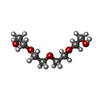
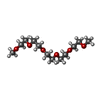





| #2: Chemical | | #3: Chemical | ChemComp-MES / | #4: Chemical | ChemComp-PG4 / | #5: Chemical | ChemComp-PG6 / | #6: Water | ChemComp-HOH / | |
|---|
-Details
| Has protein modification | Y |
|---|---|
| Sequence details | THE CONSTRUCT WAS EXPRESSED WITH A PURIFICATION TAG MGSDKIHHHHHHENLYFQG. THE TAG WAS REMOVED WITH ...THE CONSTRUCT WAS EXPRESSED WITH A PURIFICATI |
-Experimental details
-Experiment
| Experiment | Method:  X-RAY DIFFRACTION / Number of used crystals: 1 X-RAY DIFFRACTION / Number of used crystals: 1 |
|---|
- Sample preparation
Sample preparation
| Crystal | Density Matthews: 2.27 Å3/Da / Density % sol: 45.88 % |
|---|---|
| Crystal grow | Temperature: 277 K / Method: vapor diffusion, sitting drop / pH: 6 Details: 10.0000% Glycerol, 5.0000% PEG-1000, 30.0000% PEG-600, 0.1M MES pH 6.0, NANODROP, VAPOR DIFFUSION, SITTING DROP, temperature 277K |
-Data collection
| Diffraction | Mean temperature: 100 K | |||||||||||||||||||||||||||||||||||||||||||||||||||||||||||||||||||||||||||||
|---|---|---|---|---|---|---|---|---|---|---|---|---|---|---|---|---|---|---|---|---|---|---|---|---|---|---|---|---|---|---|---|---|---|---|---|---|---|---|---|---|---|---|---|---|---|---|---|---|---|---|---|---|---|---|---|---|---|---|---|---|---|---|---|---|---|---|---|---|---|---|---|---|---|---|---|---|---|---|
| Diffraction source | Source:  SYNCHROTRON / Site: SYNCHROTRON / Site:  SSRL SSRL  / Beamline: BL9-2 / Wavelength: 0.91837,0.97936,0.97922 / Beamline: BL9-2 / Wavelength: 0.91837,0.97936,0.97922 | |||||||||||||||||||||||||||||||||||||||||||||||||||||||||||||||||||||||||||||
| Detector | Type: MARMOSAIC 325 mm CCD / Detector: CCD / Date: May 13, 2009 / Details: Flat collimating mirror, toroid focusing mirror | |||||||||||||||||||||||||||||||||||||||||||||||||||||||||||||||||||||||||||||
| Radiation | Monochromator: Double crystal monochromator / Protocol: MAD / Monochromatic (M) / Laue (L): M / Scattering type: x-ray | |||||||||||||||||||||||||||||||||||||||||||||||||||||||||||||||||||||||||||||
| Radiation wavelength |
| |||||||||||||||||||||||||||||||||||||||||||||||||||||||||||||||||||||||||||||
| Reflection | Resolution: 1.45→28.479 Å / Num. obs: 28613 / % possible obs: 98.4 % / Observed criterion σ(I): -3 / Biso Wilson estimate: 15.264 Å2 / Rmerge(I) obs: 0.05 / Net I/σ(I): 15.2 | |||||||||||||||||||||||||||||||||||||||||||||||||||||||||||||||||||||||||||||
| Reflection shell |
|
-Phasing
| Phasing | Method:  MAD MAD |
|---|
- Processing
Processing
| Software |
| |||||||||||||||||||||||||||||||||||||||||||||||||||||||||||||||||||||||||||||||||||||||||||||||||||||||||||||||||||||||||||||
|---|---|---|---|---|---|---|---|---|---|---|---|---|---|---|---|---|---|---|---|---|---|---|---|---|---|---|---|---|---|---|---|---|---|---|---|---|---|---|---|---|---|---|---|---|---|---|---|---|---|---|---|---|---|---|---|---|---|---|---|---|---|---|---|---|---|---|---|---|---|---|---|---|---|---|---|---|---|---|---|---|---|---|---|---|---|---|---|---|---|---|---|---|---|---|---|---|---|---|---|---|---|---|---|---|---|---|---|---|---|---|---|---|---|---|---|---|---|---|---|---|---|---|---|---|---|---|
| Refinement | Method to determine structure:  MAD / Resolution: 1.45→28.479 Å / Cor.coef. Fo:Fc: 0.971 / Cor.coef. Fo:Fc free: 0.964 / Occupancy max: 1 / Occupancy min: 0.3 / SU B: 1.835 / SU ML: 0.036 / TLS residual ADP flag: LIKELY RESIDUAL / Cross valid method: THROUGHOUT / σ(F): 0 / ESU R: 0.061 / ESU R Free: 0.062 MAD / Resolution: 1.45→28.479 Å / Cor.coef. Fo:Fc: 0.971 / Cor.coef. Fo:Fc free: 0.964 / Occupancy max: 1 / Occupancy min: 0.3 / SU B: 1.835 / SU ML: 0.036 / TLS residual ADP flag: LIKELY RESIDUAL / Cross valid method: THROUGHOUT / σ(F): 0 / ESU R: 0.061 / ESU R Free: 0.062 Stereochemistry target values: MAXIMUM LIKELIHOOD WITH PHASES Details: 1. HYDROGENS HAVE BEEN ADDED IN THE RIDING POSITIONS. 2. A MET-INHIBITION PROTOCOL WAS USED FOR SELENOMETHIONINE INCORPORATION DURING PROTEIN EXPRESSION. THE OCCUPANCY OF THE SE ATOMS IN THE ...Details: 1. HYDROGENS HAVE BEEN ADDED IN THE RIDING POSITIONS. 2. A MET-INHIBITION PROTOCOL WAS USED FOR SELENOMETHIONINE INCORPORATION DURING PROTEIN EXPRESSION. THE OCCUPANCY OF THE SE ATOMS IN THE MSE RESIDUES WAS REDUCED TO 0.75 FOR THE REDUCED SCATTERING POWER DUE TO PARTIAL S-MET INCORPORATION. 3. ATOM RECORDS CONTAIN RESIDUAL B FACTORS ONLY. 4. GLYCEROL (GOL), 2-(N-MORPHOLINO)-ETHANESULFONIC ACID (MES) AND PEG1000 OR PEG600 FRAGMENT(PG4 AND PG6) MOLECULES ARE MODELED BASED ON CRYSTALLIZATION CONDITION.
| |||||||||||||||||||||||||||||||||||||||||||||||||||||||||||||||||||||||||||||||||||||||||||||||||||||||||||||||||||||||||||||
| Solvent computation | Ion probe radii: 0.8 Å / Shrinkage radii: 0.8 Å / VDW probe radii: 1.2 Å / Solvent model: MASK | |||||||||||||||||||||||||||||||||||||||||||||||||||||||||||||||||||||||||||||||||||||||||||||||||||||||||||||||||||||||||||||
| Displacement parameters | Biso max: 58.09 Å2 / Biso mean: 17.087 Å2 / Biso min: 8.25 Å2
| |||||||||||||||||||||||||||||||||||||||||||||||||||||||||||||||||||||||||||||||||||||||||||||||||||||||||||||||||||||||||||||
| Refinement step | Cycle: LAST / Resolution: 1.45→28.479 Å
| |||||||||||||||||||||||||||||||||||||||||||||||||||||||||||||||||||||||||||||||||||||||||||||||||||||||||||||||||||||||||||||
| Refine LS restraints |
| |||||||||||||||||||||||||||||||||||||||||||||||||||||||||||||||||||||||||||||||||||||||||||||||||||||||||||||||||||||||||||||
| LS refinement shell | Resolution: 1.45→1.488 Å / Total num. of bins used: 20
| |||||||||||||||||||||||||||||||||||||||||||||||||||||||||||||||||||||||||||||||||||||||||||||||||||||||||||||||||||||||||||||
| Refinement TLS params. | Method: refined / Origin x: 24.4983 Å / Origin y: 2.9987 Å / Origin z: -7.8432 Å
|
 Movie
Movie Controller
Controller


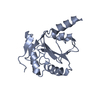

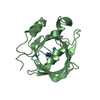
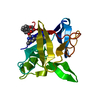

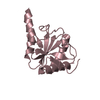


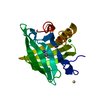

 PDBj
PDBj




